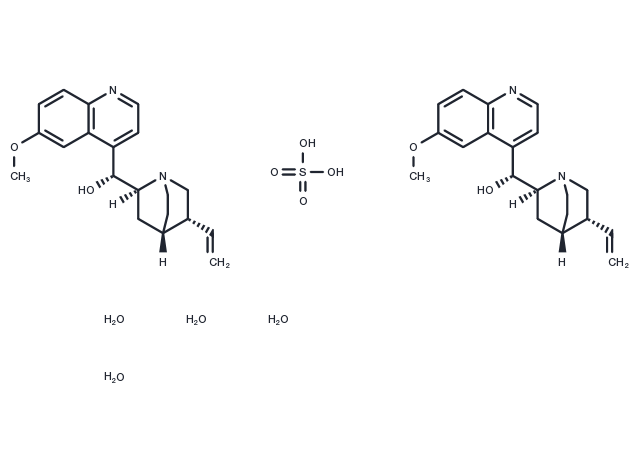keep away from direct sunlight
Powder: -20°C for 3 years | In solvent: -80°C for 1 year

Quinine sulfate dihydrate plays a major role in potassium channel blockers. It is also used as an antimalarial, anticholinergic, antihypertensive and a hypoglycemic agent. It inhibits mitochondrial ATP-regulated potassium channel. It is also used to study the metabolism of biocrystalized heme, hemozoin, in malarial parasites and to study the toxicity of heme (FP)-complexes.

| Pack Size | Availability | Price/USD | Quantity |
|---|---|---|---|
| 10 g | In stock | $ 29.00 | |
| 1 mL * 10 mM (in DMSO) | In stock | $ 45.00 |

| Description | Quinine sulfate dihydrate plays a major role in potassium channel blockers. It is also used as an antimalarial, anticholinergic, antihypertensive and a hypoglycemic agent. It inhibits mitochondrial ATP-regulated potassium channel. It is also used to study the metabolism of biocrystalized heme, hemozoin, in malarial parasites and to study the toxicity of heme (FP)-complexes. |
| Targets&IC50 | P. falciparum (60 Thai isolates):10 to 500 nM (MIC) |
| In vitro | Quinine is an alkaloid antimalarial agent that has MIC values ranging from 10 to 500 nM for 60 Thai isolates of P. falciparum. It inhibits hemozoin formation in purified trophozoites, leading to an increase in free heme, similar to the mechanism of action of chloroquine[1]. |
| In vivo | In mice, quinine reduces P. berghei parasite load in the blood with a minimum effective dose (MED) of 150 mg/kg [2]. |
| Molecular Weight | 818.97 |
| Formula | C40H58N4O12S |
| CAS No. | 6119-70-6 |
keep away from direct sunlight
Powder: -20°C for 3 years | In solvent: -80°C for 1 year
DMSO: 8.19 mg/mL (10 mM)
You can also refer to dose conversion for different animals. More
bottom
Please see Inhibitor Handling Instructions for more frequently ask questions. Topics include: how to prepare stock solutions, how to store products, and cautions on cell-based assays & animal experiments, etc.
Quinine sulfate dihydrate 6119-70-6 Others Quinine sulfate Dihydrate Quinine Sulfate inhibitor inhibit
